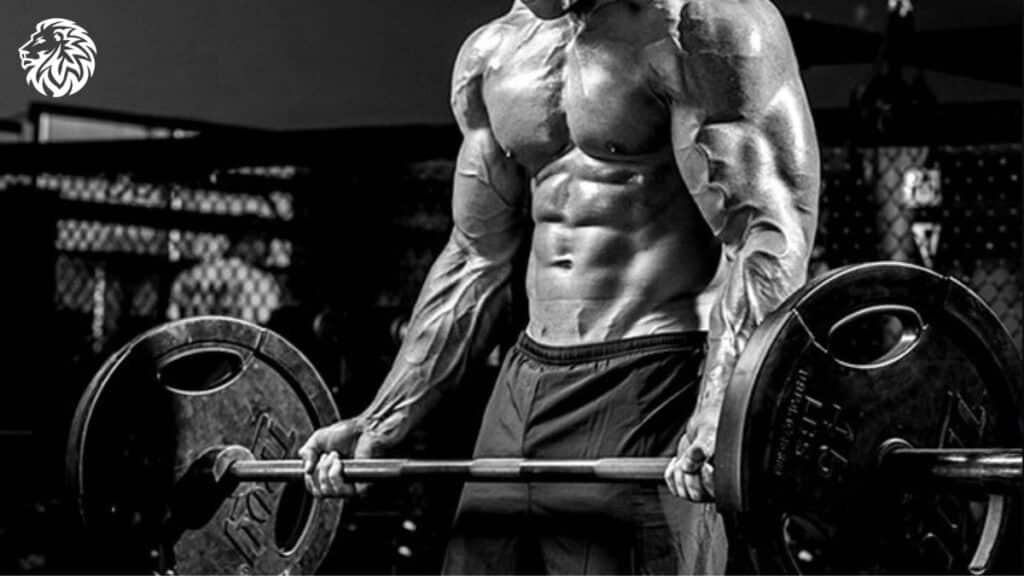Packing on muscle is key to keeping you fit and healthy. It aids in improving athletic performance, boosting metabolism, enhancing physical appearance, and playing a crucial role in maintaining an active lifestyle as we age. Furthermore, the pursuit of muscle growth encourages habits that benefit overall health. These habits can include maintaining a nutritious diet, engaging in regular physical activity, and ensuring adequate rest.
However, effectively building muscle can be a challenging task, especially without a well-researched strategy. It involves more than simply lifting weights; it requires a comprehensive approach that encompasses proper nutrition, strategic exercise routines, ample recovery time, and consistency.
The purpose of this article is to unveil eight scientifically proven strategies to facilitate rapid muscle growth. We’ll break down each one, giving you the knowledge and tools to reach your muscle-building goals faster. So whether you’re a seasoned pro trying to up your game or a newcomer stepping into the world of fitness, these strategies can offer a clear path towards noticeable, lasting muscle growth.

Understanding Muscle Growth
Before delving into the strategies to enhance muscle growth, it’s essential to understand the underlying biological process. Muscle growth, scientifically known as hypertrophy, is a response to the damage incurred in muscle fibers when they are pushed beyond their current capacity during exercise, particularly resistance and strength training.
When you engage in high-intensity workouts, microscopic tears occur in your muscle fibers. This triggers an inflammatory response, summoning satellite cells (a type of stem cell) to the injury site. These cells fuse to the damaged muscle fibers, repairing the torn tissue and increasing the muscle fiber’s size. As a result, the muscle grows larger and stronger, preparing itself for the next encounter with a similar level of stress.
Proper nutrition and exercise play pivotal roles in this process. Exercise provides the stimulus for muscle growth, but without the right nutrition, the body cannot adequately repair and build the muscle fibers.
Nutrition fuels the body for exercise and provides the necessary nutrients for muscle repair and growth post-exercise. Proteins are the building blocks of muscle. They provide the amino acids that are used in the repair and growth of new muscle fibers after a workout. Consuming sufficient protein – particularly after a workout – ensures that the body has the necessary resources for muscle protein synthesis to exceed muscle protein breakdown, a state known as positive protein balance, which is essential for muscle growth.
Moreover, carbohydrates provide the energy needed to power through workouts. In addition, healthy fats contribute to hormone regulation, including testosterone, which plays a significant role in muscle growth.
Understanding the biological process behind muscle growth and the significance of exercise and nutrition helps in creating an effective muscle-building strategy. The strategies we will explore in this article touch upon these principles and provide a comprehensive plan to facilitate rapid and sustainable muscle growth.

8 Proven Strategies for Rapid Muscle Growth
Strategy #1: Progressive Overload
Progressive overload is a fundamental principle of strength training and muscle growth. It is the practice of continually increasing the demands on the musculoskeletal system to further stimulate muscle growth and strength gains. Essentially, as your muscles adapt to the current level of stress placed upon them, you must gradually increase this stress to continue promoting muscle growth.
Progressive overload is paramount to muscle growth because muscles will not grow unless they’re challenged beyond their current capabilities. If the level of stress remains the same over time, the muscles will have no need to grow stronger or larger. By incrementally increasing the load or volume of your workouts, you compel your muscles to adapt to the new stress level. This leads to improvements in muscle size, density, and strength.
Here are some practical tips for implementing progressive overload in your workouts:
- Increase the Weight: The most straightforward method of applying progressive overload is to increase the weight you’re lifting as you get stronger. Once you can comfortably perform your usual number of sets and repetitions with a particular weight, it’s time to add more.
- Increase the Volume: Another method is to increase the volume of your workouts. This could mean doing more repetitions per set, or more sets per exercise.
- Increase the Frequency: You can also increase the frequency of your workouts. This needs to be done carefully to avoid overtraining and to give your body time to recover.
- Reduce Rest Time: By reducing the rest time between sets, you’re increasing the intensity and demand on your muscles, forcing them to work harder.
- Improve Form and Range of Motion: Improving your form and working through a full range of motion can make the same exercise more challenging and beneficial.
Remember, the key to progressive overload is gradual and consistent increase in stress. Listen to your body to avoid injury and allow sufficient recovery time. Maintaining a workout log can help you keep track of your progress and plan your overload strategy effectively.

Strategy #2: Prioritizing Protein Intake
Protein plays a vital role in muscle growth. Proteins are composed of amino acids. These are the building blocks of muscle tissue. When you engage in strength training or resistance exercise, you create microscopic tears in your muscle fibers. Protein helps repair these tears, resulting in muscle growth. Without enough protein, your body cannot rebuild and grow your muscles effectively.
The amount of protein you need to grow muscle can vary based on multiple factors like your body size, activity level, and fitness goals. A common recommendation for muscle gain is 1.6 to 2.2 grams of protein per kilogram of body weight each day. This means if you weigh 70 kilograms (approximately 154 pounds), you should aim for 112 to 154 grams of protein daily. It’s also suggested to spread this intake throughout the day for maximum absorption and utilization.
Incorporate a variety of protein-rich foods in your diet to make sure you are getting enough protein. Here’s a list of some high-protein foods to consider:
- Lean Meats: Chicken breast, turkey, lean beef, and pork are high in protein and provide essential amino acids.
- Fish: Tuna, salmon, and other fish are excellent sources of protein and also provide heart-healthy omega-3 fatty acids.
- Eggs: They’re packed with high-quality protein and are a good source of vitamins and minerals.
- Dairy Products: Greek yogurt, cottage cheese, and milk are good sources of protein. They also contain other key nutrients like calcium and vitamin D.
- Plant-based Proteins: Lentils, chickpeas, black beans, quinoa, tofu, tempeh, and edamame are great sources of protein.
- Nuts and Seeds: Almonds, peanuts, sunflower seeds, flax seeds, and chia seeds are rich in protein and healthy fats.
Prioritizing protein in your diet is crucial for muscle growth. By ensuring sufficient protein intake spread throughout your day and sourced from a variety of foods, you can support your body’s muscle repair and growth processes.
Strategy #3: Ensuring Proper Rest and Recovery
A critical yet often overlooked component of muscle growth is rest and recovery. When you engage in strength training, the exertion causes tiny tears in your muscle fibers. As explained earlier, these tears signal your body to repair and strengthen the fibers, which results in muscle growth. This repair and rebuilding process primarily occurs during rest periods, particularly when you’re sleeping.
During sleep, the body enters an anabolic (building) state, releasing growth hormones and facilitating the process of muscle protein synthesis. Adequate sleep also helps rejuvenate the nervous system, aiding in better performance during workouts.
In addition to the role of sleep, providing sufficient rest periods between workouts for specific muscle groups is also essential. Training a muscle group that hasn’t fully recovered can hinder the muscle growth process and increase the risk of injury.
Here are a few tips to ensure optimal rest and recovery:
- Aim for Quality Sleep: Try to get at least 7-9 hours of sleep per night. Create a sleep-friendly environment and establish a regular sleep schedule.
- Space Out Your Workouts: If you’re doing split-routine workouts, make sure to rest each muscle group for at least 48 hours before working it again.
- Listen to Your Body: If you feel excessively tired or sore, it’s okay to take an extra rest day. Overtraining can lead to diminished results and increased risk of injuries.
- Include Active Recovery Days: Light activities like walking, cycling, or yoga can help promote blood flow and speed up the recovery process without straining the muscles.
- Nutrition and Hydration: Consume protein-rich foods and stay well-hydrated to aid the muscle recovery process.
In essence, rest and recovery are as important as the workout itself for muscle growth. Taking the time to rest and recover allows the magic of muscle growth to happen and sets the stage for your next effective workout.

Strategy #4: Utilizing Compound Exercises
Compound exercises are multi-joint movements that work several muscles or muscle groups at one time. They are an efficient way to build strength and muscle mass as they engage more muscle fibers, burn more calories, and stimulate a more significant release of growth hormones compared to isolation exercises.
The benefits of compound exercises include:
- Efficiency: By engaging multiple muscles at once, you can get a full-body workout with fewer exercises.
- Strength and Muscle Mass: Since they target multiple muscles, they allow you to lift heavier weights, leading to increased strength and muscle growth.
- Improved Coordination: By working several muscles at once, compound exercises help improve coordination and balance.
- Functional Fitness: These exercises often mimic natural movements, improving your ability to perform everyday tasks.
Here are examples of compound exercises and the muscles they target:
- Squats: They primarily target quadriceps, but also work the glutes, hamstrings, and core.
- Deadlifts: They primarily target the back and hamstrings, but also engage the glutes, quads, forearms, and core.
- Bench Press: Primarily works the chest muscles, but also engages the shoulders and triceps.
- Overhead Press: Primarily targets the shoulders, but also engages the triceps and core.
- Pull-Ups: They primarily target the back muscles, but also engage the biceps and shoulders.
- Barbell Rows: Primarily targets the back, but also works the biceps and shoulders.
Incorporating compound exercises into your training routine can stimulate more muscle growth and make your workouts more time-efficient. However, it’s crucial to use proper form to maximize the benefits and prevent injuries. If you’re new to these exercises, consider seeking guidance from a fitness professional.
Strategy #5: Supplementing Wisely
Supplements can serve as an effective tool to support muscle growth alongside a balanced diet and a comprehensive workout plan. They can help fill nutritional gaps, enhance performance, support recovery, and boost muscle protein synthesis. However, it’s important to remember that supplements are not magic solutions. They are meant to supplement a well-rounded diet and exercise routine. They are not a replacement!
Here are some common supplements used for muscle growth:
- Protein Powders: Whey, casein, and plant-based proteins can help meet your daily protein needs, particularly when whole food is not available or convenient.
- Creatine: One of the most researched supplements, creatine can enhance strength, increase lean body mass, and aid muscle recovery.
- Branched-Chain Amino Acids (BCAAs): These include leucine, isoleucine, and valine, which are essential amino acids that can support muscle recovery and growth.
- Beta-Alanine: This supplement may reduce muscle fatigue, increase exercise capacity, and possibly enhance muscle growth in conjunction with resistance training.
- Omega-3 Fatty Acids: Found in fish oil, these fatty acids can enhance muscle protein synthesis (growth) and increase muscle strength and function.
When using supplements, it’s important to follow these recommendations for responsible usage:
- Consult a Healthcare Provider: Before starting any supplement regimen, consult with a healthcare provider or a certified sports nutritionist. They can guide you based on your specific health conditions and goals.
- Research: Choose supplements that are third-party tested for safety and efficacy. Look for evidence-based information on the supplement and its potential benefits and side effects.
- Use as Directed: Always follow the manufacturer’s instructions. Taking more than the recommended dose does not necessarily yield better results and can potentially lead to adverse effects.
- Remember, Supplements are Supplementary: Supplements should not replace a balanced diet. They’re meant to fill in the gaps of your nutritional needs.
- Monitor Your Progress and Adjust as Needed: Track how the supplements are affecting your performance and make adjustments as necessary.
Supplements can be a useful tool to aid muscle growth when used wisely. They should be used in conjunction with a balanced diet and regular exercise routine. Always remember that there’s no magic pill for muscle growth, and progress requires time, effort, and consistency.

Strategy #6: Consistency in Training
When it comes to muscle growth, consistency is king. The most well-designed workout program or nutrition plan is worthless without the consistency to stick with it. Consistent training provides a continuous stimulus for muscle growth, allowing you to progressively overload your muscles and make ongoing gains. Conversely, inconsistent training can lead to a cycle of progress and regression, limiting your ability to make substantial muscle gains.
Maintaining consistency does not mean that every workout has to be an intense, all-out effort. It means regularly performing your workouts, adhering to your nutrition plan, getting adequate sleep, and balancing periods of hard training with appropriate recovery.
Here are a few tips to maintain consistency and motivation in your workouts:
- Set Clear Goals: Having clear, measurable goals can provide a sense of direction and motivation. Breaking down your long-term goals into smaller, short-term ones can make the process more manageable and rewarding.
- Create a Routine: Plan your workouts like any other important appointment. Having a consistent workout schedule can help make exercise a habit.
- Mix Things Up: Variety can prevent boredom and promote a broader range of muscle stimulation. Try different workout styles, exercises, or sports to keep things interesting.
- Find a Workout Buddy: Having a workout partner can increase accountability and make workouts more enjoyable.
- Listen to Your Body: Avoid burnout by incorporating rest days and active recovery. Remember, it’s a marathon, not a sprint.
In essence, the ability to stick to your fitness routine over time is a significant predictor of achieving your muscle growth goals. By finding ways to maintain consistency, you can ensure you’re continuously progressing towards those goals.
Strategy #7: Proper Hydration
Hydration is essential when it comes to muscle growth and recovery. Since our muscles are mostly water, it’s no surprise that staying hydrated has a lot of benefits when it comes to muscle development. Water is like a delivery service for your muscles, bringing them the nutrients they need, while also taking out the trash—aka waste products from muscle metabolism. In addition, it keeps your joints healthy and helps your body absorb food. This provides your muscles with the fuel they need to recover and grow.
Not drinking enough water and becoming dehydrated will cause you to feel weaker, leading to muscle cramps and slowing down your recovery. Staying adequately hydrated is, therefore, essential for optimal muscle function and growth.
Here are some recommendations for daily water intake:
- General Guidelines: While individual water needs can vary, a common guideline is to drink at least 8 glasses, or about 2 liters, of water a day. However, active individuals or those living in warmer climates may need more.
- During Exercise: Aim to consume 7-10 ounces of water every 10-20 minutes during your workout to replace the fluid you lose through sweat.
- Monitor Your Body: The color of your urine can be a good indicator of your hydration status. Aim for pale, light-colored urine to ensure you’re adequately hydrated. If your urine is dark, it might indicate that you’re not drinking enough water.
- Don’t Wait Until You’re Thirsty: Thirst is a sign that your body is already dehydrated. Try to sip water throughout the day to stay hydrated.
Remember, while water is generally the best choice for hydration, you can also meet your fluid needs through other beverages and high-water foods. Just be mindful of the sugar content in certain drinks, as excessive sugar can counteract your muscle-building efforts.

Strategy #8: Emphasizing Post-Workout Nutrition
Post-workout nutrition is a vital aspect of muscle growth. After a strenuous workout, your body is in a catabolic state with depleted glycogen stores and broken-down muscle proteins. The right nutrients can shift your body to an anabolic state, replenishing energy stores and facilitating muscle repair and growth.
A successful post-workout meal should aim to accomplish the following:
- Replace Glycogen Stores: Consuming carbohydrates after your workout helps replenish glycogen, the primary energy source used during exercise.
- Decrease Protein Breakdown: Consuming protein can help repair and rebuild muscle proteins, promoting muscle growth and recovery.
- Increase Protein Synthesis: The combination of protein and carbohydrates can stimulate insulin production, a hormone that aids in muscle protein synthesis.
Here are some recommended foods and nutrients to include in post-workout meals:
- Protein: As discussed, protein is crucial for muscle repair and growth. Some quick and convenient protein sources include protein shakes, Greek yogurt, cottage cheese, or a serving of lean meat.
- Carbohydrates: Aim for simple carbs that can be quickly digested and absorbed, helping to replace glycogen stores. Examples include fruits like bananas or apples, rice, pasta, bread, or oatmeal.
- Healthy Fats: While fats might slow down absorption, they do not reduce the benefits of protein and carbs. Some healthy fats include avocados, nuts, and nut butters.
- Hydration: Replenishing fluids lost through sweat is crucial after exercise. Water is a great choice, but for longer or more intense workouts, a sports drink may be needed to replace electrolytes.
The importance of post-workout nutrition should not be underestimated. Consuming the right balance of proteins, carbohydrates, and fats after exercise can optimize the body’s recovery process, supporting rapid muscle growth.

Conclusion
Achieving rapid muscle growth involves more than just lifting heavy weights; it requires a comprehensive approach that integrates various strategies. The eight proven strategies discussed in this article provide a holistic view of how one can optimize muscle growth. To recap:
- Progressive Overload: Gradually increase the intensity of your workouts to challenge your muscles and stimulate growth.
- Prioritizing Protein Intake: Protein is crucial for muscle repair and growth. Aim to incorporate sufficient protein into your daily diet.
- Ensuring Proper Rest and Recovery: Rest is when the actual muscle growth occurs. Make sure you’re getting enough sleep and rest between workout sessions.
- Utilizing Compound Exercises: Compound exercises engage multiple muscles at once, promoting efficient and significant muscle growth.
- Supplementing Wisely: Supplements can support your muscle growth efforts but should be used responsibly and in conjunction with a balanced diet and exercise routine.
- Consistency in Training: Regular and consistent workouts provide the ongoing stimulus needed for muscle growth.
- Proper Hydration: Stay well-hydrated to support optimal muscle function and recovery.
- Emphasizing Post-Workout Nutrition: Consuming the right balance of nutrients after your workout can optimize your body’s recovery and muscle growth.
Remember, everyone’s body responds differently to exercise and nutrition, and muscle growth takes time. While the promise of rapid muscle growth is enticing, it’s crucial to remain patient, consistent, and committed to your fitness journey. With time, perseverance, and the right strategies in place, you will see progress in your muscle growth journey. Good luck!







